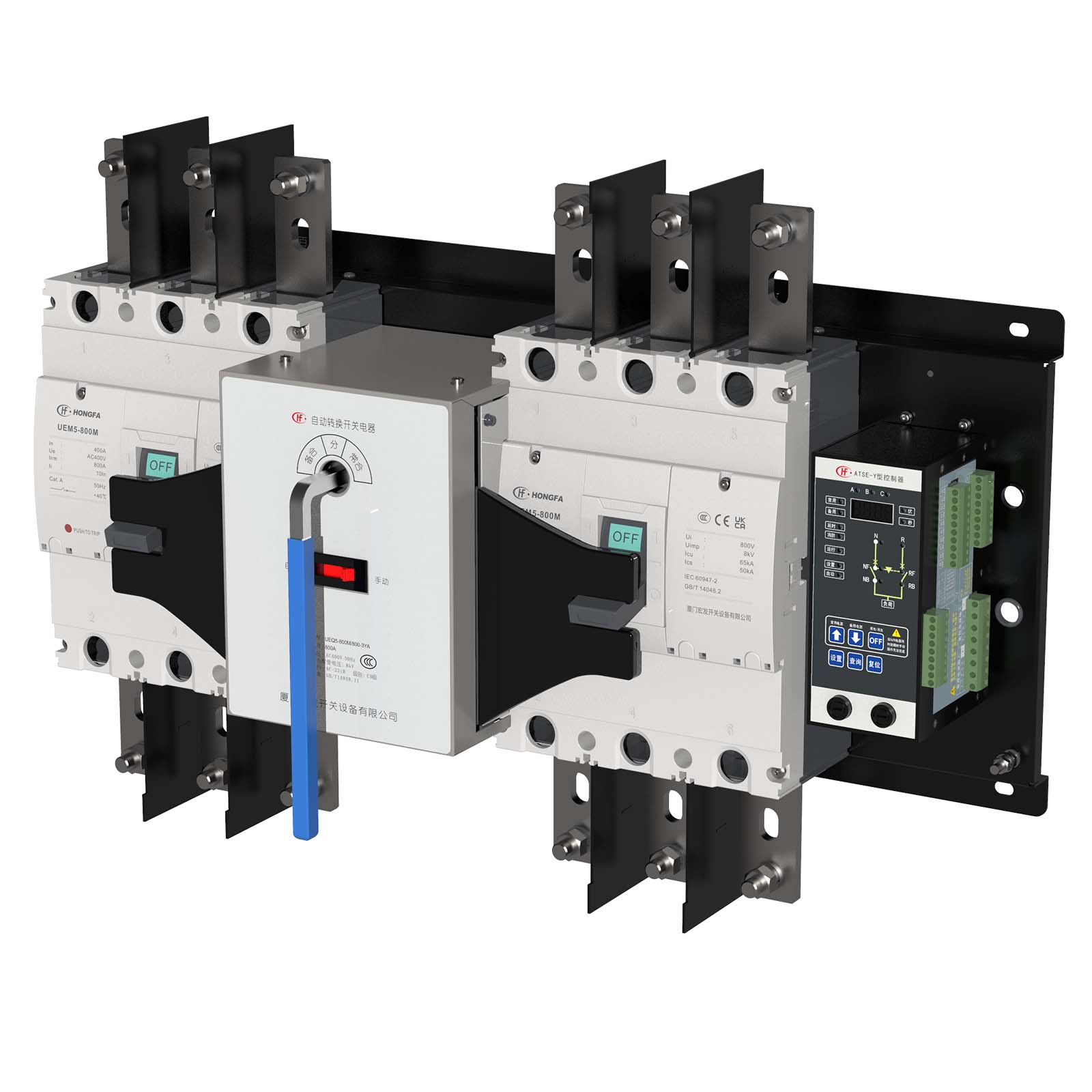In modern power systems, it is crucial to ensure the continuity and reliability of power supply. As a key power equipment, Automatic Transfer Switch (ATS) can automatically switch to backup power when the main power fails, thereby ensuring the uninterrupted operation of key equipment and systems. ATS is divided into two types according to its design and function: PC-level and CB-level, each of which is suitable for different power supply schemes and load requirements. This article will deeply explore the application of PC-level and CB-level ATS in different power supply schemes, analyze its working principle, design considerations, and how to effectively control the scope of faults to ensure the stability and safety of power supply.

The UEQ5-800
Application of Automatic Transfer Switch products
1. Application of CB-level Automatic Transfer Switch in trunk power supply schemes
When a short circuit occurs in a certain circuit, due to the selective coordination of the circuit breaker, the branch circuit breaker and the main power circuit breaker of ATSE will be activated at the same time, the main circuit breaker on the trunk will not be activated, and the trunk will be powered normally. Since the Automatic Transfer Switch detects the power supply at the Automatic Transfer Switch inlet, the ATSE will not switch to the backup power supply, so the fault range is limited to the distribution box, which will only affect the power supply of other branches in the distribution box, and will not expand the fault range to the entire power supply circuit.
2. Application of PC-level Automatic Transfer Switch
Application of PC-level Automatic Transfer Switch in radial power supply scheme. When a short circuit fault occurs in any branch, the branch and the upper normal power supply main circuit breaker operate at the same time. The Automatic Transfer Switch detects that the normal power supply is out of power and automatically switches to the backup power supply to continue power supply. At this time, the fault circuit has been cut off, which will not affect the power supply of other branches and will not expand the fault range. In this power supply scheme, there is no need to add protective electrical appliances in front of the PC-level ATSE.
3. Application of PC-level Automatic Transfer Switch in trunk power supply scheme
Trunk power supply system with protective electrical appliances at the front end of PC-level Automatic Transfer Switch. In this power supply scheme, when a short circuit occurs in a distribution box in the trunk, the circuit breaker in front of the dual power switch in this distribution box will be disconnected first, and the backup power supply will be enabled, so that the fault range will be controlled within this distribution box, and the fault range will not be expanded; if the circuit breaker in front of the dual power switch is removed, when a short circuit occurs in a distribution box, the main switch on the trunk will be activated, thereby expanding the fault range to the entire trunk. Since these loads are important loads, the dual power supply does not guarantee power supply and loses its meaning of use.
The protective device added before the PC-level Automatic Transfer Switch can be a fuse or a circuit breaker. The specific choice is that the protective current of the protective device should be lower than the rated short-circuit limiting current of the PC-level Automatic Transfer Switch.
Conclusion: Through a comprehensive analysis of ATS, we realize that different types of ATS – whether PC-level or CB-level – have their own unique design considerations and applicable scenarios. Choosing a suitable ATS should not only consider its conversion speed and tolerance, but also its protection function and applicability in a specific power supply scheme. PC-level ATS is particularly suitable for power supply of critical loads such as fire protection due to its fast switching speed and high tolerance, while CB-level ATS is suitable for power supply of ordinary loads due to its short-circuit protection function.
In practical applications, the selection and configuration of ATS should be determined according to specific engineering requirements and load characteristics. Whether it is a radial or trunk power supply scheme, the correct design and application of ATS can effectively control the scope of faults and ensure the continuous power supply of important loads. With the continuous advancement of technology, the performance and functions of ATS are also constantly improving, but for electrical professionals, a deep understanding of the working principle and characteristics of ATS is the basis for ensuring the stable operation of the power system and meeting modern power supply needs.

Automatic Transfer Switch UEQ5 series
This article deeply analyzes the application and advantages of PC-level and CB-level Automatic Transfer Switch (ATS) in different power supply schemes. The conclusion shows that the selection of a suitable ATS requires comprehensive consideration of conversion speed, tolerance and protection function. PC-level ATS is suitable for power supply of critical loads due to its fast switching and high tolerance; CB-level ATS is suitable for ordinary loads due to its short-circuit protection function. Correct design and application of ATS is crucial to control the scope of faults and ensure the continuity of power supply. As technology advances, ATS performance continues to improve, but a deep understanding of its working principles is crucial to ensuring stable operation of the power system and meeting modern power supply needs.
Post time: 7 月-15-2024


